
Animal Bite and Sting Wound Treatment Page Menu: 1 2 3 4 5 6 7 Next>>
Treating Animal Bites and Stings in the Golden Age of Piracy, Page 3
Animal Attacks: Sharks
Several 'attacks' by fish have already been discussed, but sharks seem to have held a special place in the list of animals considered dangerous by sailors based on the number of sea-authors from this time who mention them.
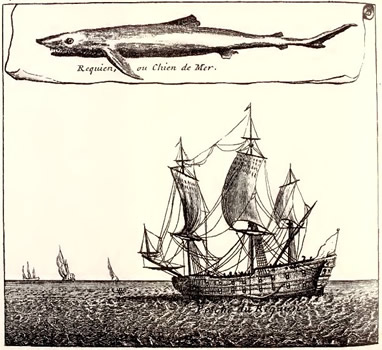
Ship and Shark. From Nouveau Voyage aux Isles de l'Amerique,
by Jean-Baptiste Labat, Vol. 1 (1722)
Sharks were known to follow ships, sometimes for long periods. William Bosman, explaining what happened on the slave ships off the coast of Africa said that "when our ships depart from those Places, they [sharks] sometimes follow them for three Weeks or a month"1. Merchant/slaver captain Thomas Phillips similarly explained in his 1694 journal, "we have like wise seen divers of them [Africans] eaten by the sharks, of which a prodigious number kept about the ships in this place, and I have been told will follow her hence to Barbadoes, for the dead negroes that are thrown over-board in the passage."2 The sharks probably followed the ships because they were a ready and regular source of food thrown overboard.
Jovial French priest Jean-Baptiste Labat mentioned that during his journey from France to Martinique a shark followed their ship for two or three days before the crew decided to catch it.3Upon opening the creature up, "we found everything which had been thrown overboard since it had accompanied us in its belly, even the carpenter’s hammer."4 Merchant sailor Edward Barlow explained in his diary entry for a 1663/4 Portugal that "many time sharks, which are thereabout in abundance, which will keep company with a ship and take anything that is heaved overboard, they are so hungry and ravenous"5. Similar to Labat, Barlow reported that when sharks were caught, they found many of the things they had tossed overboard in their stomachs including sheep feet, a dead rat and "a whole ox-hide, being newly flayed from the ox."6
Sharks were often mentioned in these accounts because they would devour men's corpses which had been thrown overboard during burials at sea. Francis Rogers somewhat indelicately commented that after
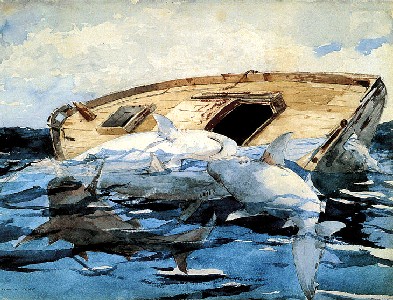
Artist: Winslow Homer (1885)
they had sewn their deceased cook into a blanket and put him overboard, the next "morning 10 or 12 sharks hankered about the ship for such another meal, they having met with the poor greasy cook."7
Sea surgeon John Atkins somewhat more tactfully explained, "I have seen [sharks] frequently seize a Corpse, as soon as it was committed to the Sea; tearing and devouring that, and the Hammock that shrouded it, without suffering it once to sink, tho’ a great Weight of Ballast in it."8
Perhaps the most descriptive account of sharks eating a corpse during this period comes from Dutchman William Bosman:
I have sometimes, not without horror, seen the dismal Rapaciousness of these Animals [sharks]; four or five of them together shoot to the bottom under the Ship to tear the dead Corps[e] to pieces, at each bite an Arm, a Leg, or the Head is snapt off; and before you tell twenty they have sometimes divided the Body amongst them so nicely that not the least Particle is left; nay, not so much as any of the Intrails; and if any one of them happens to come too late for his share, he is ready to eat up the others, and they attack one another with the greatest violence in the World9
Having seen such things, it should not be surprising that sailors would be wary of sharks. In addition to their devouring corpses, sharks attacked sailors. In his account of Henry Every's pirates, captured sailor Philip Middletone noted that one of this crew members was killed by a shark after the crew broke up, although he doesn't supply details.10
Swimming could be particularly dangerous. When Domingo Navarette's ship was trapped by a calm off the coast of Mexico, "The Seamen
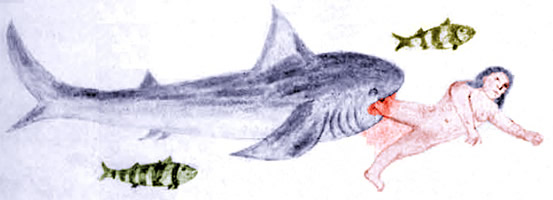
Artist: Edward Barlow
Shark Attack. From Barlow’s Journal of his Life at Sea in King’s Ships, East and West Indiamen & Other
Merchantman From 1659 to 1703 (17th c.)
and Souldiers would leep into the Sea to cool them selves but would sometimes return hastily to escape the Sharks."11 Edward Barlow warned that sharks
will seize upon any man if he should be swimming in the water, so that in some places men, as they have been swimming for recreation, have had their legs bitten off and also have been carried quite away and never seen more, so that great heed must be taken to them when anyone is swimming where any of these fish are12
Francis Rogers had a close call in 1702 when he went "overboard a-swimming but [I] had like to have paid dear for it, for I had but just got into the ship again, when appeared a shark ranging alongside for what he could get, and soon after another"13. Sailor Philip Ashton had an even closer call after escaping from Edward Low's pirates and making his way to an island off Honduras. He was swimming from one island to another when,
a Shovel nos'd Shark [probably actually a guitarfish], (of which the Seas thereabouts are full, as well as Alligators) struck me in the Thigh just as I set my Foot to Ground, & so grounded himself (I suppose) by the shoalness of the Water, that he could not turn himself to come at me with his Mouth, & so, thro' the Goodness of GOD, I escaped falling a Prey to his devouring Teeth. I felt the Blow he gave me some hours after I had got ashoar.14
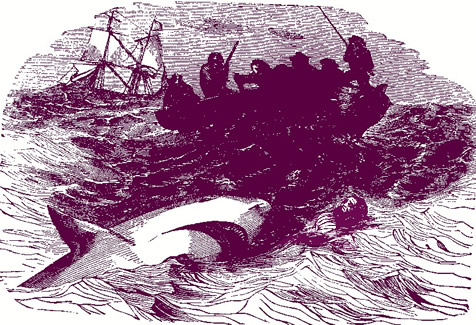
Escape From a Shark, From Thrilling Adventures by Land and Sea,.James O. Brayman (1852)
Sailor John Read was not so lucky when "venturing to swim, had both his Legs snapp’d off by a Shark, which at the second Bite, before we could get him aboard, took off the Bottom of his Belly, so that he was dead before we could take him up."15
When they captured a slave ship and didn't want to be bothered with caring for the slaves, Bartholomew Roberts' crew set fire to it, leaving the slaves to fend for themselves. Captain Chaloner Ogle recounts the details of the episode: "those who jump'd over-board to avoid the Flames that spread towards them, were immediately seized by the Sharks who tore their Limbs off in the sight of those Villains, who took a cruel satisfaction in looking on."16
Because of their reputation (and the fact that they could and would eat them), sailors sometimes caught and killed sharks, particularly after they had had a taste of human flesh. William Bosman posited that sharks ate the bodies thrown overboard, 'relished' the taste and so continued following the ship, waiting for the more bodies to be tossed to them.17 Francis Rogers' recounting of the sharks circling his ship after the 'poor greasy cook' was tossed overboard also attests to the belief that sharks would develop an appetite for people once they had had one.
Several stories of catching sharks can be found in the period sea literature. When a hammer-head shark bit off a child's leg on St. Kitts, Father Jean-Baptiste Labat described how a Carib Indian "armed himself two good well-sharpened bayonets, and after raising his courage by drinking a couple of glasses of rum, he dived into the sea."18 He let the shark, "which had now got the taste of human flesh", rush at him seven or eight times, during which he dived under it with the knives pointed upwards so that they cut through its stomach.
Sailors had a much simpler method for dispatching sharks. Francis Rogers describes the process in some detail:
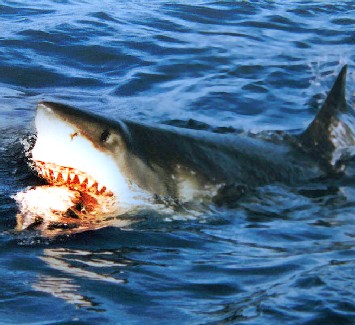
Photo: Brocken Inaglory - Great White Shark Going for Bait
we had a large hook for that purpose called a shark hook, about the thickness of our fingers, which is fastened to an iron chain about a yard long to prevent his biting it in pieces all which is made fast to some rope in the ship, and being baited with a piece of beef or pork, of about 3 or 4 pounds, is thrown over the ship’s stern. As soon as he hears the noise in the water he makes up to it, and if the ship has any way through the water or he anything hungry, he is not very ceremonious about it, but turns himself on his back and swallows hook and all. As soon as we see him take it, we strive to jerk it through his jaw to secure him.19
Rogers advised that the shark should be "played out on the water [for] sometime" because when it realizes it is caught, "he twists and rings with prodigious strength, and flaps and beats the water with his tail with mighty fury."20 Labat explained that when the sailors caught a shark on a ship it was "pulled up on the deck with a tackle, and a sailor struck it a heavy blow on its back with an axe to stop it thrashing about so violently."21
If a shark was hauled into a boat without being quickly dispatched, William Bosman explained just how dangerous the tremendous thrashing of animal's tail could be. "[W]hoever comes near him loses either an Arm or Leg, or at least hath it broken to pieces."22 That would result in more work for the surgeon who would either have to repair the fracture(s) or properly amputate the remains of the limb.
1 William Bosman, A New and Accurate Description of the Coast of Guinea, 1705, p. 282; 2 Thomas Phillips, 'A Journal of a Voyage Made in the Hannibal', A Collection of Voyages and Travels, Vol. VI, Awnsham Churchill. ed., p.219; 3,4 Pere Jean-Baptiste Labat, The Memoirs of Pére Labat 1693-1705, 1970, p. 18; 5,6 Edward Barlow, Barlow’s Journal of his Life at Sea in King’s Ships, East and West Indiamen & Other Merchantman From 1659 to 1703, p. 83; 7 Francis Rogers, "The Journal of Francis Rogers", Three Sea Journals of Stuart Times, Bruce S. Ingram ed., 1936, p. 163; 8 John Atkins, A Voyage to New Guinea and Brazil, 1735, p. 46; 9 William Bosman, A New and Accurate Description of the Coast of Guinea, 1705, p. 281-2; 10 “36. Philip Middleton, from Narrative of Philip Middleton, 4 August, 1696. Calendar of State Papers, Colonial: America and the West Indies, 1696-1697, item. 517iii.”, Pirates in Their Own Words, Ed Fox, ed., 2014, p. 174; 11 Domingo Navarrete, The Travels and Controversies of Friar Domingo Navarrete 1618-1686, 1962, p. 45; 12 Barlow, p. 83; 13 Francis Rogers, p. 150; 14 Philip Ashton, Ashton’s Memorial, 1726, p. 56; 15 Edward Cooke, A Voyage to the South Sea and Round the World in the Years 1708 to 1711, 1969, p. 56; 16 Chaloner Ogle, Pyrates Lately taken by Captain OGLE, 1723, p. 39; 17 Bosman, p. 282; 18 Labat, p. 114; 19,20 Francis Rogers, p. 150; 21 Labat, p. 19; 22 Bosman, p. 282;
Animal Attacks: Snakes
Several sea accounts from this time contain warnings about venomous snakes, often including descriptions of the types of snakes seen in various places.
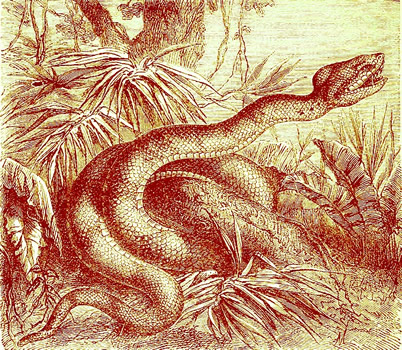
Snake Attacking. From Reptiles and birds, by Parker Gilmour (1883)
There are actually not many actual sea-based accounts of people being bitten by them. Still, there are a few and so they earn a place on the list of animals that attacked sailors.
During his time in the Philippines in 1686-7, privateer William Dampier twice mentioned the snakes in Mindinao, explaining that "we had several came aboard our Ship when we lay in the River."1 He warned that some were very venomous.2 Jean-Baptiste Labat similarly advised that some of the islands off Grenada had "a number of very dangerous poisonous snakes."3 He explained that this was the only place those particular snakes were found without going into any more detail.
Dampier gave a somewhat more vivid account of venomous snakes he encountered in Honduras while working there with the logwood cutters. "The green Snakes are no bigger about than a Man's Thumb, yet 4 or 5 Foot long: The Backs are of a very lively green colour, but their Bellies inclining to yellow."4 He goes on to tell about nearly grabbing a bird that was near him only to realize that one of these snakes had caught the bird and was wrapped around it. These were probably one of the many Honduran palm pit vipers, many of which are colored green and yellow and of about the size he mentioned.
After Philip Ashton escaped to Roatán in Honduras from pirate Edward Low, he described several snakes he encountered. One was "as big round as a Man's Wast, tho' not above 12 or 14 Feet long. These are called Owlers. They look like old fallen Stocks of Trees covered over with a short Moss, when they lye at their length; but they more usually lye coiled up in a round."5 He noted that while one had opened its mouth when he encountered it, it was 'nothing venomous'. This may have been a boa constrictor which is native to the area, non-venomous and can grow to be about that size. However, Ashton also said some of the smaller snakes were venomous, "particularly one that is called a Barber's Pole, being streaked White and Yellow."6
It may be noticed that the only sailor's accounts to mention snakes in the Caribbean are from Honduras. Herpetologist Mark O'Shea says there are only five Caribbean islands with endemic venomous snakes.
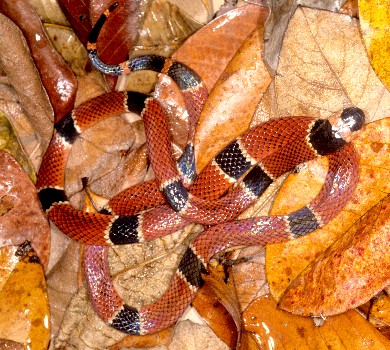
Photo: Marcos Guerra - Coral Snake (Micrurus nigrocentus), Smithsonian Inst.
This includes Micrurus ruatanus babaspul or the Central American coral snake found on Roatán, which may be the snake Philip Ashton was talking about since it's Creole name is the word for 'barber pole.' This snake is normally striped black and red, which doesn't match Ashton's description.7 All may not be lost in making the identification, however. Albino coral snakes appear in mottled reds, yellows and whites.
The other islands O'Shea mentions as having endemic venomous snake species include: Great Corn Island, Nicaragua, home to the black, yellow and red coral snake Micrurus nigrocinctus babaspul; Aruba, home to the Crotalus durissus unicolor or Aruba rattlesnake, which is actually yellow and white, although the stripe is longitudinal; St. Lucia, home to the St. Lucia lancehead (Bothrops caribbaeus); and Martinique, where the St. Lucia lancehead (Bothrops lanceolatus) resides. In addition, there are a variety of non-endemic snakes in the area which appear to come from the mainland. Isla de Margarita is home to the Venezuelan coral snake, Lansberg's hog-nosed pit viper and neotropical rattlesnakes. Los Testigos islands contain South American rattlesnakes. Trinidad has Amazonian bushmasters residing on it.8
Three period sailor's accounts feature a description of water snakes. The first is from Francis Rogers who, while in Aden, Yemen in 1702, encountered "a large water snake, which are pretty common here; they are said sometimes to get into the ship’s scuppers, and have been known to have bite the men dangerously."9
The other two accounts of water snakes are from Woodes Roger's privateering voyage from September of 1709. One of the accounts is from Rogers himself, who observed the snake going up the

Artist: Edward Cooke - Drawing of the Water Snake Which Climbed the Dutchess (1712)
side of his companion ship the Dutchess.10 However, the more descriptive account comes from Edward Cooke, the captain of the Dutchess, who explained that the snake "was coming up the Side of our Ship, and our Men beat it off; the Spaniards say, there is no Cure for such as are bit by them. Some are yellow, spotted with black, and of several Colours, Sorts, and Sizes."11 Cooke included a sketch of the snake in his book. A variety of venomous aquatic coral snakes are to be found in Central and South America, which may have been what they encountered.
For actual snake attacks from the era, there is really only one sea incident in the literature reviewed. This is also from Woodes Roger's privateering voyage, during the time that their ships were being careened at 'Port a Penees' near Panama. (Possibly Puerta Piña?) in 1709. Both Cooke's12 and Rogers'
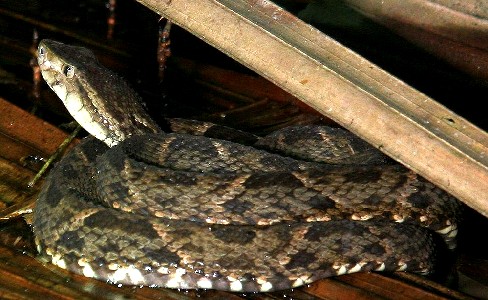
Photo: Wiki User Caspar S. - A Fer-de-lance or Bothrop asper
accounts mention it, with Rogers' account being the more informative in this instance:
A Negro belonging to the Dutchess was bit by a small brown speckl’d Snake, and died within 12 Hours, notwithstanding the Doctor us’d his utmost Endeavours to save him. ...One of the same sort of Snakes that kill’d the Negro was found on our Forecastle this Morning, and kill’d by our Men; we suppose it came aboard on the Cable, they being often seen in the Water.13
Rogers also mentions that there were "an abundance" of deadly snakes in the area.14 Panama certainly seems to contain a wide variety of venomous snakes. Many of these have coloring which could fit the description given by Rogers including fer-de-lances (Bothrops aspers) and bushmasters (snakes of the Lachesis genus).
1 William Dampier, Memoirs of a Buccaneer, Dampier’s New Voyage Round the World -1697-, 1968, p. 254; 2 Dampier, Memoirs, p. 220-1; 3 Pere Jean-Baptiste Labat, The Memoirs of Pére Labat 1693-1705, 1970, p. 136; 4 William Dampier, “Part II: Mr. Dampier's Voyages to the Bay of Campeachy”, Voyages and Descriptions, Vol. II, 1700 p. 63; 5,6 Philip Ashton, Ashton’s Memorial, 1726, p. 50; 7,8 Mark O'Shea, Venomous Snakes of the World, 2008, p. 52; 9 Francis Rogers, "The Journal of Francis Rogers", Three Sea Journals of Stuart Times, Bruce S. Ingram ed., 1936, p. 163; 10 Woodes Rogers, A Cruising Voyage Round the World, 2004, p. 141; 11 Edward Cooke, A Voyage to the South Sea and Round the World in the Years 1708 to 1711, 1969, p. 301; 12 Cooke, p. 154-5; 13,14 Rogers, p. 123
Animal Attacks: Tigers
Tiger attacks are not very common in the golden age of piracy sea accounts. In fact, all of the detailed tiger attacks on humans come from one book. However, tigers are mentioned as a threat in two different accounts, so they are included here. (Besides, who doesn't like to look at tigers?)
Merchant captain Nathaniel Uring says, "All along the Coast [of Jamaica] are several kinds of ravenous Beasts, as Tygers, Leopards, Tyger Cats, Snakes, and Baboons. The Tygers or Leopards were so bold at Plantane River,
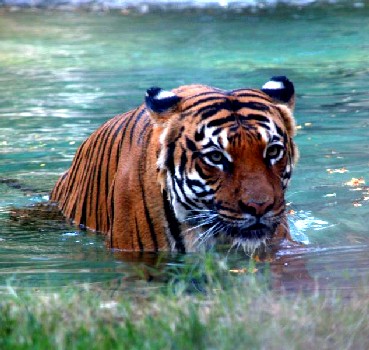
Artist: Joshua Barnett - Malayan Tiger in the Water
that they frequently seized the Poultry among the Habitations, and were twice among the Houses whilst I was there."1 However, he gives no account of sailors being attacked.
Scottish sea-captain Alexander Hamilton provides several accounts of tigers attacking men during his time in India. In one of them, he himself encountered a tiger in Karwar, India which was ready to attack. "As soon as he saw me, he squatted his Belly to the Ground, and wagged his Tail, and crawled slowly towards me."2 Anyone owning a cat will recognize this as hunting behavior. Hamilton got within ten yards of the tiger, adjusted his rifle so he could use it as a club and made a lot of noise. He said this appeared to scare the tiger off.
Most of his accounts of tigers and seamen are second-hand. Hamilton explained that in Cox's Bazar and Sagar Island (India) "they are so pestered with Tigers, that there could be no Security for human Creatures to dwell on them, nay, it is even dangerous to land on them, or for Boats to anchor near them, for in the Night they have swimmed to Boats at Anchor, and carried Men out of them"3.
He also gives a story from the overgrown edges of the Hughley River in Balasore, India "which give Shelter to many fierce and troublesom Tigers, who do much Mischief."4 A man who was waiting to depart on a ship left his boat,
and had no sooner put himself in a Posture near the Bushes, but out leaps a Tiger, and caught both his Buttocks in his Mouth, and was for carrying him away, but one of the Seamen in the Boat seeing the Tragedy, took up a Musket, and placed a Bullet in the Tiger’s Head, while the Man in his Mouth was helpless. ...the wounded Man was carried on board of his Ship, and the Surgeon made a perfect Cure of the Wounds. I saw the Marks of the Wounds three or four Years after that Accident happened to him.5
Hamilton doesn't explain what the doctor did, but since tigers are not venomous, he likely used the usual simple wound care procedures.
1 Nathaniel Uring, A history of the voyages and travels of Capt. Nathaniel Uring, 1928, p. 161; 2 Alexander Hamilton, British sea-captain Alexander Hamilton's A new account of the East Indies, 17th-18th century, 2002, p. 223; 3 Hamilton, p. 324; 4,5 Hamilton, p. 322

